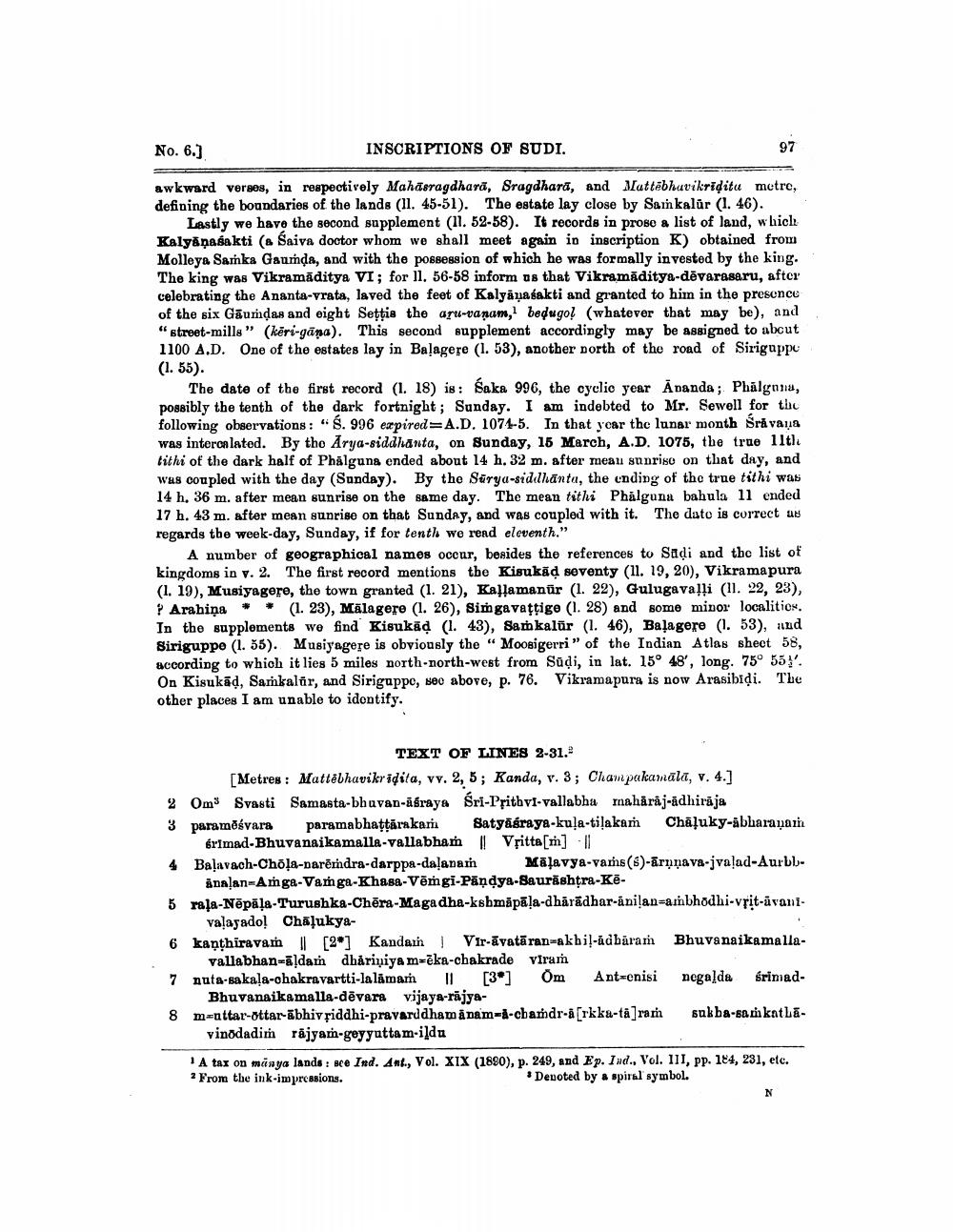________________
No. 6.]
awkward verses, in respectively Mahasragdhara, Sragdhara, and Mattebhavikriḍitu metre, defining the boundaries of the lands (11. 45-51). The estate lay close by Samkalür (1. 46).
Lastly we have the second supplement (11. 52-58). It records in prose a list of land, which Kalyāṇasakti (a Saiva doctor whom we shall meet again in inscription K) obtained from Molleya Samka Gaumda, and with the possession of which he was formally invested by the king. The king was Vikramaditya VI; for 11. 56-58 inform us that Vikramaditya-devarasaru, after celebrating the Ananta-vrata, laved the feet of Kalyanasakti and granted to him in the presence of the six Gaumḍas and eight Seṭṭis the aru-vanam, bedugol (whatever that may be), and "street-mills" (keri-gana). This second supplement accordingly may be assigned to about 1100 A.D. One of the estates lay in Balagere (1. 53), another north of the road of Siriguppe (1.55).
INSCRIPTIONS OF SUDI.
The date of the first record (1. 18) is: Saka 996, the cyclic year Ananda; Phalguna, possibly the tenth of the dark fortnight; Sunday. I am indebted to Mr. Sewell for the following observations: "Ś. 996 expired=A.D. 1074-5. In that year the lunar month Śravaṇa was intercalated. By the Arya-siddhanta, on Sunday, 15 March, A.D. 1075, the true 11th. tithi of the dark half of Phalguna ended about 14 h. 32 m. after mean sunrise on that day, and was coupled with the day (Sunday). By the Surya-siddhanta, the ending of the true tithi was 14 h. 36 m. after mean sunrise on the same day. The mean tithi Phalguna bahula 11 ended 17 h. 43 m. after mean sunrise on that Sunday, and was coupled with it. The date is correct as regards the week-day, Sunday, if for tenth we read eleventh."
A number of geographical names occur, besides the references to Sadi and the list of kingdoms in v. 2. The first record mentions the Kisukaḍ seventy (11. 19, 20), Vikramapura (1. 19), Musiyagere, the town granted (1. 21), Kallamanur (1. 22), Gulugavalli (11. 22, 23), ? Arahiņa (1. 23), Mälagere (1. 26), Sim gavaṭṭige (1. 28) and some minor localities. In the supplements we find Kisukaḍ (1. 43), Samkalur (1. 46), Balagere (1. 53), and Siriguppe (1. 55). Musiyagere is obviously the "Moosigerri" of the Indian Atlas sheet 58, according to which it lies 5 miles north-north-west from Sūḍi, in lat. 15° 48', long. 75° 55'. On Kisukaḍ, Samkalar, and Siriguppe, see above, p. 76. Vikramapura is now Arasibiḍi. The other places I am unable to identify.
TEXT OF LINES 2-31.2
[Metres: Mattebhavikridita, vv. 2, 5; Kanda, v. 3; Champakamālā, v. 4.] 2 Om3 Svasti Samasta-bhuvan-asraya Sri-Prithvi-vallabha mahārāj-ädhirāja 3 paramosvara paramabhaṭṭarakaṁ Satyasraya-kula-tilakam Chaluky-abharaṇaṁ
śrimad-Bhuvanaikamalla-vallabham | Vritta [m] ||
4 Balavach-Chola-narēmdra-darppa-dalanam
5 raja-Nepāla-Turushka-Chera-Magadha-kshmäpala-dhārādhar-anilan-ambhodhi-vrit-avani
valayadol Chalukya
6 kanthiravam [2] Kandai Vir-avataran-akhil-adharam Bhuvanaikamallavallabhan-aldam dhariniya m=ēka-chakrade viram
7 nuta-sakala-chakravartti-lalamaṁ II [3]
Bhuvanaikamalla-dēvara vijaya-rājya
97
Malavya-vams (6)-arnnava-jvalad-Aurbb
analan-Amga-Vamga-Khasa-Vemgi-Pandya-Saurashtra-Ke
πρ
Ant-enisi negalda
8 m-nttar-ottar-abhivriddhi-pravarddhamanam-a-chamdr-a [rkka-ta] ram
vinodadim rajyam-geyyuttam-ildu
śrimad
sukba-samkatha
A tax on manya lands: see Ind. Ant., Vol. XIX (1890), p. 249, and Ep. Ind., Vol. III, pp. 184, 231, etc. 2 From the ink-impressions.
Denoted by a spiral symbol.
N




